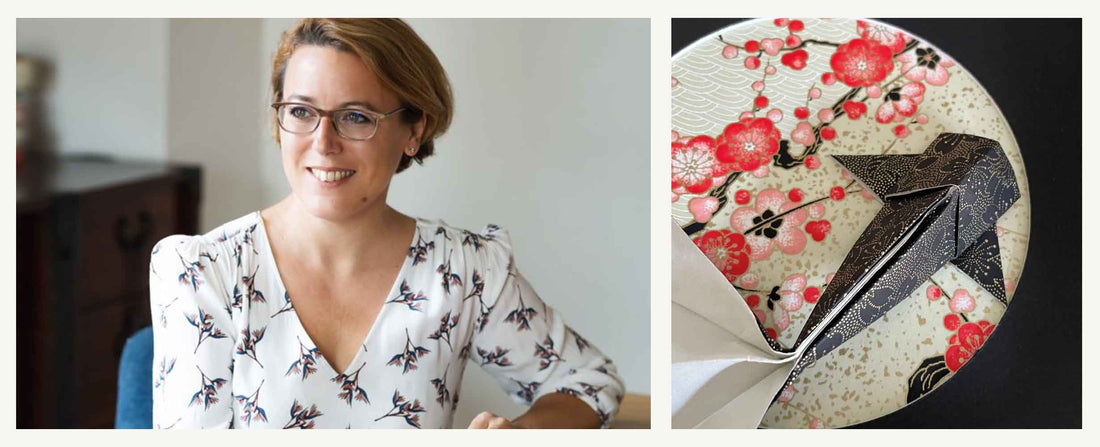
The poetic world of Hanawa Origami | Spotlight on the artist
Share
Today I present Audrey's creations discovered on her Instagram page @hanawa_origami
A few years ago, Audrey discovered Origami during a workshop with her daughters, which revealed a passion for working with paper.

Later, she made a decisive trip to Tokyo ✈️, where she became familiar with the famous Yuzen Washi paper. Things began to take a different turn for our designer.
Having left for Japan with her family to follow her husband, who had been offered a professional opportunity, Audrey was in fact to embark on a veritable voyage of initiation, discovering the know-how and age-old traditions of Origami.
For three years, she glimpsed the roots of this art form and perceived a powerful creative energy all around her.
In Japan, paper folding is one of the many pillars of traditional culture, often discovered as early as kindergarten, and practised for pleasure, ritualistically or on the occasion of festivals. This strong anchoring in everyday life is bound to leave its mark on a person who is not accustomed to it, and to stimulate the imagination.
From then on, with her new-found knowledge and a new source of inspiration, Audrey continues to create. With her entrepreneurial spirit, she decided to found Hanawa Origami.
Since then, Audrey has been creating poetic collections inspired by Japan. Unique creations or small series for original, Japanese-style interior design.
Active on social networks, she launched her first trade shows in Japan. Since her return to France, she has been present at a number of major Parisian fairs on the theme of Japan. Some of her works can also be found on her website
Haikus in relief
Audrey's work is inspired by nature at its most poetic and iconic in Japan. These are butterflies like the Sasakia Charonda, Japan's national butterfly, or the emblematic Sakura, which appear on cherry trees between March and April.

Like haikus, the poetic scenes she imagines seem to celebrate the evanescence of things. Where Western art had invented the memento mori, making death its center of gravity, Japanese tradition makes the sensation of existing a powerful poetic motor, enabling everyone to become aware of the essential nature of the present moment.
Audrey's work also reminds me of a principle I studied when I became interested in the Bauhaus: the absence of boundaries between artist and craftsman.

This idea is also found in the work of Nobel Prize-winning writer Claude Simon (see his edifying Stockholm Speech).
The colors and geometric shapes of the folded papers are also in a figurative in-between. The nature of the creative material, the famous washi paper, is part of what is shown, per se, beyond the formal play of folds that weave links with the natural world.
One of the means employed by modern art is to show the material, the medium through which art makes itself sensitive, and at the same time, through washi paper, this process takes us back to centuries of tradition... vertiginous, isn't it!

By the way, what is washi paper ?
Washi, also pronounced wagami (和紙) literally "Japanese paper", is the generally patterned and colorful paper that has been handcrafted in Japan since the 6th century. This paper with long, interwoven paper mulberry fibers is light, flexible and strong. In 2014, washi was included in Unesco's list of Intangible Heritage of Humanity.
Washi is made using a labor-intensive process that involves soaking the plant fibers in water, beating them into a pulp, and then forming the pulp into sheets using a mold. The sheets are then dried and pressed.
Washi is used in a wide variety of products, including stationery, origami paper, calligraphy paper, and even clothing. It is also used in the production of traditional Japanese crafts such as shoji screens and ukiyo-e prints.
In addition to its practical uses, washi is also an important part of Japanese culture and tradition. It is often used in religious ceremonies and festivals, and it is also a popular subject for Japanese art and literature.
Here are some of the traditional Japanese traditions that involve washi:
- Shoji screens: Shoji screens are traditional Japanese sliding doors made with washi paper. They are used to divide rooms, create privacy, and let in light.
- Ukiyo-e prints: Ukiyo-e prints are a type of Japanese woodblock print that was popular in the 17th to 19th centuries. Ukiyo-e prints were often printed on washi paper.
- Origami: Origami is the Japanese art of paper folding. Origami is often made with washi paper because of its strength and durability.
- Calligraphy: Calligraphy is the art of writing beautiful letters. Japanese calligraphy is often done with a brush and washi paper.
- Noh theater: Noh theater is a traditional Japanese form of theater. Noh masks are often made with washi paper.
Washi is a beautiful and versatile paper with a rich history. It is an important part of Japanese culture and tradition, and it continues to be used in a variety of ways today.
Would you like to create too?
Take a tour of our workshop and download our pack of creative art papers now.
